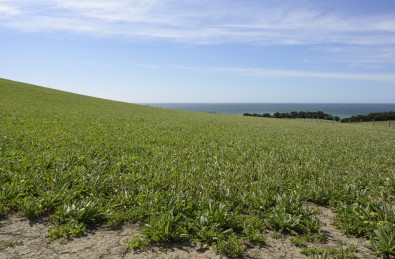Soil carbon
This page summarises potential actions to maintain or increase soil carbon, but where research is ongoing.
Diverse swards and modified grazing regimes
Swards with mixed species may provide increased resilience for continued growth and recovery during periods of extreme weather, such as prolonged drought. Nitrogen-fixing species also reduce the need for inorganic nitrogen fertiliser.
There’s some evidence globally that establishing swards with more diverse species, including plants with deeper roots such as lucerne, increases carbon inputs and storage in soil at lower depths. However, evidence to date from New Zealand studies is inconclusive.
Despite the importance of grazing in New Zealand, there are few studies of the impacts of grazing timing, intensity and duration on soil carbon stocks. Modifying grazing regimes could lead to opportunities to reduce soil carbon losses and build up stocks but evidence for this is currently lacking.
Adding organic elements
It might be possible to increase soil carbon levels by using carbon-rich additives, known as amendments, in your soil. Manure is the most common example of an amendment.
The addition of biochar, a form of charcoal which stabilises carbon stored in trees, is being promoted in some countries as it hypothesised that it can increase soil carbon stocks, increase water holding capacity, increase nutrient supply and reduce nitrous oxide emissions. Limited studies have been conducted in New Zealand to date. Practicality and cost effectiveness are key issues with respect to adding biochar to pastures. The potential emissions from producing and transporting biochar to the farm could also outweigh the benefit of carbon stored in the soil.
Importing carbon as supplemental feed also brings additional carbon onto livestock farms. However, most of the feed is converted to carbon dioxide when consumed by animals with only a proportion being returned to the land in manure. In addition, soil carbon losses may occur from land where supplemental feeds are grown.
Keeping soils vegetated
Keeping soils covered with actively growing vegetation ensures plant roots are continually adding carbon into the soil. When soils are bare, microbes continue to degrade soil organic matter, so there’s a risk that soil carbon levels will decrease during these periods. This is particularly important when re-sowing pasture and growing supplemental feed crops. Ensuring the period with bare soils is kept to a minimum will help reduce losses. This may involve growing a cover crop in some situations.

However, losses via this route may be relatively short-lived. Once land is revegetated soil carbon will start to build up again and after a few years may well return to pre-disturbance levels.
It’s important to avoid continuous growing of supplemental feed crops like maize or fodder beet within a grazing pasture-based farm on the same paddock. By returning cropped paddocks to pasture, you can allow lost carbon to recover in the soil. The time taken to rebuild soil carbon after losses following a couple of years of cropping is being actively explored, but it is likely to be more than seven years.
Improving irrigation management
Optimising irrigation could reduce nitrous oxide and help to preserve soil carbon and emissions.
There’s evidence that carbon stocks in New Zealand’s carbon-rich soils are lower under irrigation than under adjacent non-irrigated sites. This contrasts with irrigated land in parts of the world that are normally arid.

The very limited available evidence suggests that using different irrigation application rates according to soil type and maintaining soils in a state of slight water deficit, could reduce soil carbon losses, especially during warm summer-like conditions.
Avoiding over-irrigation, and avoiding grazing when soils are saturated by irrigation or rainfall, could also help reduce nitrous oxide emissions. However, although we know in general that emissions of nitrous oxide are higher under wet, disturbed soils the effect is difficult to quantify or predict.
Using technology such as detailed soil mapping, soil moisture monitoring, and Variable Rate irrigation can all be utilised to ensure that irrigation is managed efficiently and effectively.
Full inversion tillage

The quantity of soil carbon stored in agricultural soils tends to decrease with depth. Burying carbon-rich topsoils and exposing sub soils that have the capacity to store more carbon could lift soil carbon stocks. Modelling studies in New Zealand suggest that full inversion tillage can bring low carbon soil to the surface, where it will rapidly gain carbon following pasture renewal, and place high carbon soil deeper in the soil profile without this carbon being rapidly lost. Field studies are now underway to test whether this is a practical method for increasing soil carbon stocks in pastoral soils suitable for ploughing. Early results are promising, with benefits for soil carbon, plant productivity and nitrous oxide emissions in some situations but information on the long-term implications across a range of situations are needed before the practice can be recommended.
More information
For more Ag Matters content on soil carbon, see here.
Other helpful soil carbon resources include:
- The NZAGRC soil carbon research programme web page
- This presentation to the 2023 NZAGRC conference
- This NZAGRC webinar on soil carbon and nitrous oxide in New Zealand's pastoral systems, from June 2022
Published: June 27, 2023

